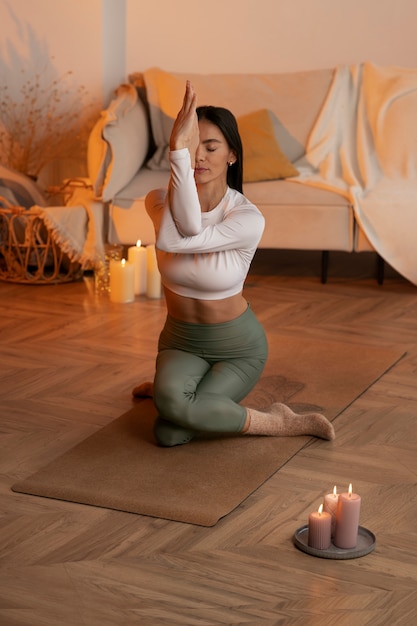
A yoga body isn’t just about being flexible; the ancient practice can also improve memory, heart health, and bone strength, according to Anna Magee.
In the UK, we’re spending a whopping £790 million annually on yoga classes and mats. While new, quirky forms of yoga like rage or naked yoga, paddle-board yoga, and dog yoga are emerging, science continues to validate yoga’s real benefits.
Researchers at UCLA discovered that a three-month yoga and meditation program was more effective than memory exercises for reducing age-related brain impairment. Another study found it improved sleep in breast cancer survivors.
When Lucy Edge, a 53-year-old former advertising executive, fell into depression, she chose yoga over prescribed antidepressants. She took a six-month break from work, traveled to India to learn yoga, and returned feeling happier and more content. Lucy has written three books about yoga and started Yoga Meds on her website, Yogaclicks.com, listing over 300 clinical trials on yoga’s benefits for issues like arthritis, insomnia, and obesity.
Research also suggests that a 12-week course of yoga and meditation can improve spatial and visual memories in adults over 55, while also reducing depression, anxiety, and stress.
If you’re looking to improve your heart health, research shows that yoga can lower heart disease risk as effectively as conventional exercise like brisk walking. This is because yoga helps reduce stress—a major factor in heart disease. Practicing yoga can improve blood pressure, cholesterol, and weight, which are all risk factors for heart disease.
For those new to yoga, Charlotte Watts has created a series of stress-reducing gentle yoga poses perfect for beginners, detailed in her book, The De-Stress Effect. Anna Ashby recommends Restorative yoga, which involves supported postures held for up to 12 minutes, giving the nervous system a break and reducing stress.
Yoga can also aid in pain management. Musculoskeletal physiotherapist and yoga teacher Sarah Shone developed yoga classes for back pain relief, with 87% of participants reporting reduced pain. Yoga is included in NICE guidelines as a useful exercise for lower back pain and can help with incontinence by targeting pelvic floor muscles. It’s also weight-bearing, which can increase bone density.
If you’re just starting, inform your yoga teacher about any health issues and choose gentle styles like Hatha or Iyengar yoga. If you have specific conditions like back pain, consult your doctor to see if you’re eligible for subsidized yoga courses.
When it comes to yoga props, a good mat can make a big difference. Consider where you’ll keep it, whether you need to transport it, and your height. A thicker mat provides better joint protection and cushioning.
Healthista recommends the Elephant Cork Yoga mat from Valka Yoga, priced at £69.95. It’s eco-friendly, made from organic cork and natural rubber, and comes with a carry strap, 15-day money-back guarantee, and a one-year warranty. Cork is naturally antimicrobial and odor-resistant, making it great for hot yoga.
Adding a Valka yoga block (£19.95) can also enhance your practice, providing extra length and stability for more difficult poses.
Yoga is adaptable for everyone, whether you’re bendy or not. For a relaxing experience, try Yin or Restorative yoga. For more energy, opt for Vinyasa Flow. Iyengar yoga focuses on alignment and precision and is beginner-friendly. Anusara yoga combines alignment with flowing movements to upbeat music. Yoga Therapy specifically helps with injury or illness healing.
Lucy Edge’s latest book, “Down Dog Billionaire,” is available on Amazon.